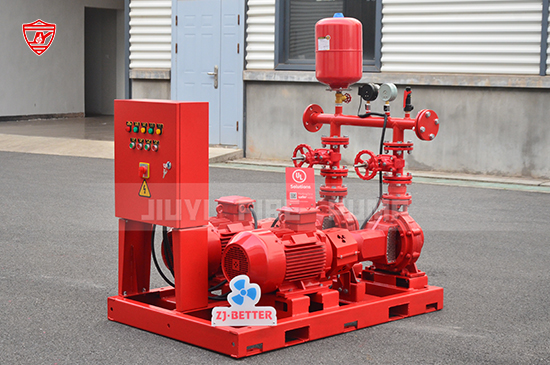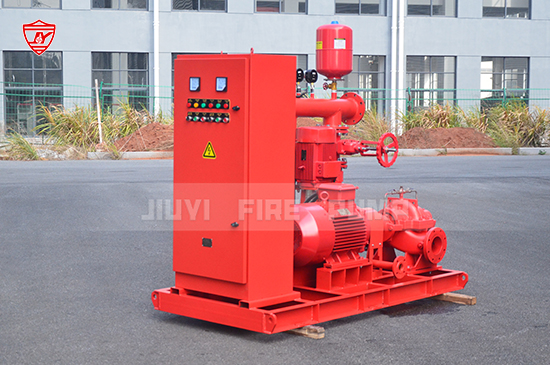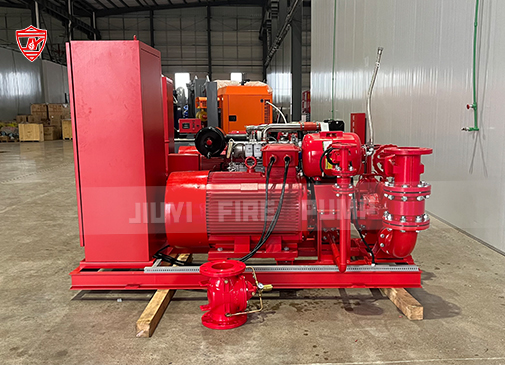Fire pumps are critical components in fire protection systems, designed to deliver water under pressure to sprinkler and standpipe systems during an emergency. While routine operation of a fire pump system should be relatively quiet aside from normal motor or engine hum, unusual fire pump noises can signal underlying mechanical, hydraulic, or electrical issues. Early identification and correction of such problems can prevent costly repairs, system failure, and non-compliance with NFPA 20 standards.
In this article, we’ll walk you through a comprehensive troubleshooting guide to diagnose and resolve the most common causes of noisy fire pumps.

Common Types of Unusual Fire Pump Noises
Understanding the type of noise you hear is the first step toward diagnosis. Here are typical sounds and their potential causes:
1. Grinding Noise
-
Cause: Worn or damaged bearings
-
Risk: Misalignment, shaft damage, overheating
-
Fix: Inspect and replace bearings, check shaft alignment.
2. High-Pitched Whining or Screeching
-
Cause: Cavitation due to low inlet pressure or blockage
-
Risk: Impeller damage, reduced performance
-
Fix: Check for suction line obstructions, verify NPSH (Net Positive Suction Head).
3. Thumping or Banging (Water Hammer)
-
Cause: Sudden valve closure or pump starting/stopping
-
Risk: Pipe damage, joint failure
-
Fix: Install soft-start devices or surge arrestors; avoid abrupt valve operation.
4. Humming or Buzzing
-
Cause: Electrical issues, such as loose connections or faulty motor windings
-
Risk: Overheating, fire hazard
-
Fix: Inspect electrical system, tighten connections, test motor insulation.
5. Vibration Noise
-
Cause: Misalignment, imbalance, worn couplings
-
Risk: Premature wear and structural damage
-
Fix: Perform vibration analysis, align shafts, and balance rotating parts.
Troubleshooting Step-by-Step
Step 1: Conduct a Visual and Audible Inspection
-
Observe the source of the noise (pump, motor, piping).
-
Determine when the noise occurs: startup, during operation, or shutdown.
-
Check for visible signs of wear, leakage, or vibration.
Step 2: Review Maintenance Logs
Look at previous service records:
-
When were the bearings last lubricated or replaced?
-
Has there been a history of cavitation?
-
Have there been recent electrical or control panel issues?
Step 3: Compare Against NFPA 20 Guidelines
Ensure your system is compliant:
-
Check pump and driver alignment.
-
Confirm minimum inlet pressures and suction piping configurations.
-
Verify that isolation and check valves are operating properly.
Step 4: Conduct Vibration Analysis
A vibration meter or sensor can reveal:
-
Misalignment between pump and motor
-
Imbalance in the rotating components
-
Looseness in baseplate or foundation
Compare against industry baseline values to determine severity.
Step 5: Perform Pump Performance Testing
Conduct a flow test:
-
Measure discharge pressure and flow.
-
Look for signs of decreasing efficiency or flow loss, which may relate to internal wear or impeller damage.
Step 6: Inspect the Impeller and Wear Rings
Disassemble the pump if necessary:
-
Examine impeller blades for pitting, cracks, or erosion.
-
Measure wear ring clearances to ensure they are within tolerance.
Cavitation often causes impeller degradation, which produces noise and reduces system effectiveness.
Preventive Measures to Avoid Noisy Fire Pumps
Once noise issues are resolved, implement preventive measures:
✔ Routine Inspections
-
Weekly visual checks
-
Monthly no-flow tests
-
Annual flow performance tests
✔ Proper Installation
-
Rigid mounting with vibration isolators
-
Adequate spacing for suction and discharge piping
-
Correct motor-pump shaft alignment
✔ Regular Lubrication and Maintenance
-
Use recommended grease/oil types and schedules
-
Replace seals and bearings per manufacturer guidelines
✔ Maintain Proper Suction Conditions
-
Ensure flooded suction or adequate NPSH
-
Avoid long or undersized suction piping
✔ Install Monitoring Systems
-
Use vibration sensors and noise detectors
-
Set thresholds for automatic alerts
When to Call a Professional
While basic troubleshooting can resolve many issues, call a professional if:
-
The pump must be dismantled to check internal parts
-
Vibrations exceed safe operating limits
-
You observe electrical faults or insulation damage
-
NFPA 25 or local code compliance is at risk
Common Fire Pump Noise Myths
❌ Myth: “A little noise is normal.”
Truth: Minor noises might indicate early-stage bearing or impeller wear.
❌ Myth: “All fire pump systems make the same noise.”
Truth: Systems vary in design, and abnormal noises must be evaluated in context.
❌ Myth: “Just increasing pressure will solve cavitation.”
Truth: Cavitation is a suction-side problem. Pressure at the discharge won’t fix it.
Documenting and Reporting Issues
Maintain clear records of:
-
Noise type and timing
-
Actions taken
-
Parts replaced
-
Test results
This documentation helps identify recurring problems and supports future maintenance planning.
Final Thoughts
Unusual noises in your fire pump system should never be ignored. They are early warning signs that something in your system may be misaligned, worn, or failing. Timely diagnosis, regular maintenance, and adherence to NFPA 20 standards are key to ensuring your fire pump system stays operational when it's needed most.
If your team lacks the expertise or equipment to fully diagnose the issue, reach out to a certified fire pump technician or your fire pump manufacturer for detailed support



